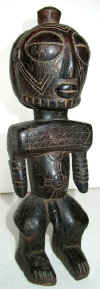 |
 |
 |
TRIBAL AFRICAN ART
BUYU
(BABUYE, BABUYU, BASIKASINGO, BOYO, BUYE, BUYI, WABUYE)
Democratic Republic of
the Congo
The
Buyu occupy a small area between the Lualaba River and the northwestern end of Lake
Tanganyika, in the eastern Democratic Republic of the Congo. In this region overrun by
innumerable shifts in population, groups of diverse origins coexisted in the same village:
Lega, Bembe, Buyu, Bangubangu, and Binji, all of whose primary activity would be the hunt.
This occasioned numerous rituals, and it also was an important factor in
cultural exchanges and in the mobility of the population. The Buyu population is declining and their
culture disintegrating due to the expansion of the Bembe over the past 70 years into their
territory. Among the six clans that form the Buyu ethnic group, three are known
predominantly for their male and female ancestor figures. These venerated chiefs of the
Buyu led migrations, founded villages, or provided exceptional leadership.
The Buyu worship to nature spirits and to ancestors. When bad luck arrives, they try to understand the will of the ancestors either through dream interpretation or divination. The Buyu immortalized their chiefs and ancestors in vigorous figures characterized by a massive head, long, cylindrical torsos, square shoulders, and bulging trunk. The face is triangular in shape. The forehead is marked by circularly arched eyebrows and the eyes have a coffee-bean shape. The jaw dominates the mouth, and the chin is angular. A hatched motif simulates a stylized beard. These statues are stylistically so close to those by neighboring ethnic groups who also live on the west banks of the lake – such as the Holoholo, the Binji, and the Bangubangu – that it is sometimes difficult to tell the styles apart. These figures are kept in small huts and are displayed in series of five to seven, and have either a beneficial or a malefic influence on everyday life, so they require a cult and associated offerings. Before leaving for the hunt, the men go there to rub their weapons with white clay; if the hunt has been good, they offer a few trophies upon their return. Sometimes bust figures were also left outside the ancestor shrine, either in the village or in the forest.